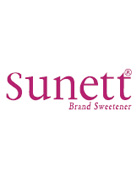Artificial Sweeteners
Blue, Yellow and Coming Soon...
If you're shopping for foods with less sugar in them, it's hard to miss the artificial sweeteners we're covering this week. They seem to be in everything.
Aspartame | Common & Trade Names (Canderel, Equal, Nutrasweet) - 4 Calories Per Gram
James M. Schlatter discovered aspartame in 1965 while working for G. D. Searle & Company. He was synthesizing aspartame in the process of working on an anti-ulcer drug candidate. Some aspartame got on his finger, and then he licked it as he reached for a piece of paper. Noticing it was sweet, Schlatter tried some in his coffee and aspartame was officially discovered. Aspartame is an aspartic acid-containing dipeptide like alitame and neotame.
It is 160 to 220 times sweeter than sugar and was first approved by the FDA in 1981 for use in foods.
There is a problem with aspartame. While it's not an allergen, some people with the genetic disease phenylketonuria (PKU) and pregnant women with hyperphenylalaninemia (high levels of phenylalanine in their blood) have a problem with aspartame. They are unable to effectively metabolize the amino acid phenylalanine, one of aspartame's components.
High levels of phenylalanine in body fluids can cause brain damage. That's why the FDA has ruled that anything that contains aspartame must include a warning to phenylketonurics that the product contains phenylalanine.
There was more potentially bad news. In 2005 the European Food Safety Authority (EFSA) released its review of the long-term carcinogenicity study of aspartame conducted by the European Ramazzini Foundation (ERF). It all started when scientists from ERF concluded that aspartame causes cancer and that current uses and consumption of the sweetener should be re-evaluated. In response to that, EFSA reviewed the ERF study to see if aspartame should be taken off the market. EFSA concluded the following:
- ERF's conclusion that aspartame is a carcinogen is NOT supported by the data; and
- EFSA sees no need to further review its earlier scientific opinion on the safety of aspartame or to revise the Acceptable Daily Intake.
The FDA has requested the data from the ERF study and in April, 2007, they released a statement that said:
"FDA has completed its review concerning the long-term carcinogenicity study of aspartame entitled, "Long-Term Carcinogenicity Bioassays to Evaluate the Potential Biological Effects, in Particular Carcinogenic, of Aspartame Administered in Feed to Sprague-Dawley Rats," conducted by the European Ramazzini Foundation (ERF), located in Bologna, Italy. FDA reviewed the study data made available to them by ERF and finds that it does not support ERF's conclusion that aspartame is a carcinogen. Additionally, these data do not provide evidence to alter FDA's conclusion that the use of aspartame is safe."
Follow up studies have not shown any linkage between aspartame and cancer.
Sucralose | Common & Trade Names (Splenda) - 0 Calories Per Gram
In 1976 Leslie Hough and Shashikant Phadnis were testing chlorinated sugars as chemical intermediates. One day Phadnis was told to test the powder, but he mistakenly thought he was supposed to taste it. So he did. The compound was incredibly sweet, about 600 times sweeter than sugar. Hough and Phadnis spent the next year working with the company Tate & Lyle until they came up with what would become known as Splenda.
Canada was the first to approve Sucralose for use in 1991, followed by Australia in 1993, New Zealand in 1996, the United States in 1998 and the European Union in 2004. By 2006 it had been approved for sale in over 60 countries.
More than 110 studies were conducted to identify toxic effects including carcinogenic, reproductive and neurological effects. None were found and sucralose was deemed safe for human consumption.
Some of the pre-approval tests on sucralose DID show potential toxicity, but those results were considered before the FDA and the European Commission approved sucralose for general human consumption.
When we first wrote this article in 2006, we felt it would be beneficial to get more long-term studies on the use of sucralose. Ten years later (2016), there have been numerous additional studies and none show any short-term or long-term harm for people who consume this product.
 Acesulfame-K (potassium) | Common & Trade Names (Sunett, Sweet One) - 0 Calories Per Gram
Acesulfame-K (potassium) | Common & Trade Names (Sunett, Sweet One) - 0 Calories Per Gram
This artificial sweetener was discovered in 1967 in Germany and is manufactured by Hoechst, a German chemical company.
150-200 times sweeter than sugar, it was first approved by the FDA in 1988 for use as a tabletop sweetener and other specific uses. In 1998 the FDA approved its use in beverages. Finally, in December of 2003, it was approved for general use in foods, with the exception of meat or poultry.
As of 2006, we found 88 studies that evaluated and supported the safety of Acesulfame-K. Two studies suggested the additive might cause cancer, but those results could not be replicated in follow-up studies.
The Center for Science in the Public Interest (CSPI) requested that the FDA conduct more tests. Since the CSPI request, the European Commission for Health & Consumer Protection re-evaluated acesulfame-K and released their report on March 9, 2000. The European Commission re-affirmed, based on all available research up to that date, acesulfame-K is safe.
Next week we'll tell you about "hidden" artificial sweeteners like sugar alcohols.
Click Here to take our Quiz on Artificial Sweeteners.
Part 1 2 3 4
Call for a FREE Consultation (305) 296-3434
CAUTION: Check with your doctor before
beginning any diet or exercise program.
11/26/2006
Updated 7/2/2012
Updated 3/11/2014
Updated 2/17/2016


